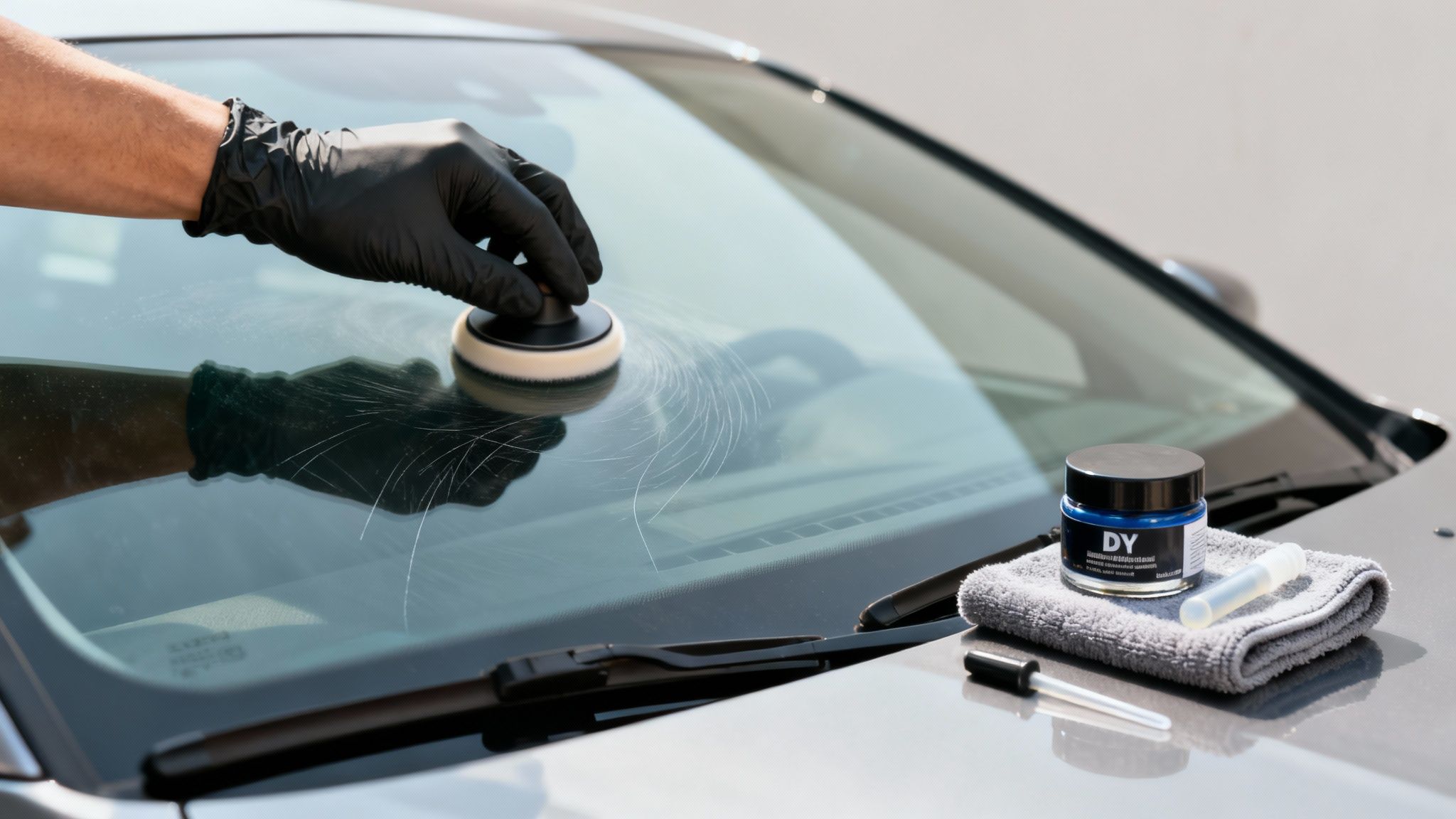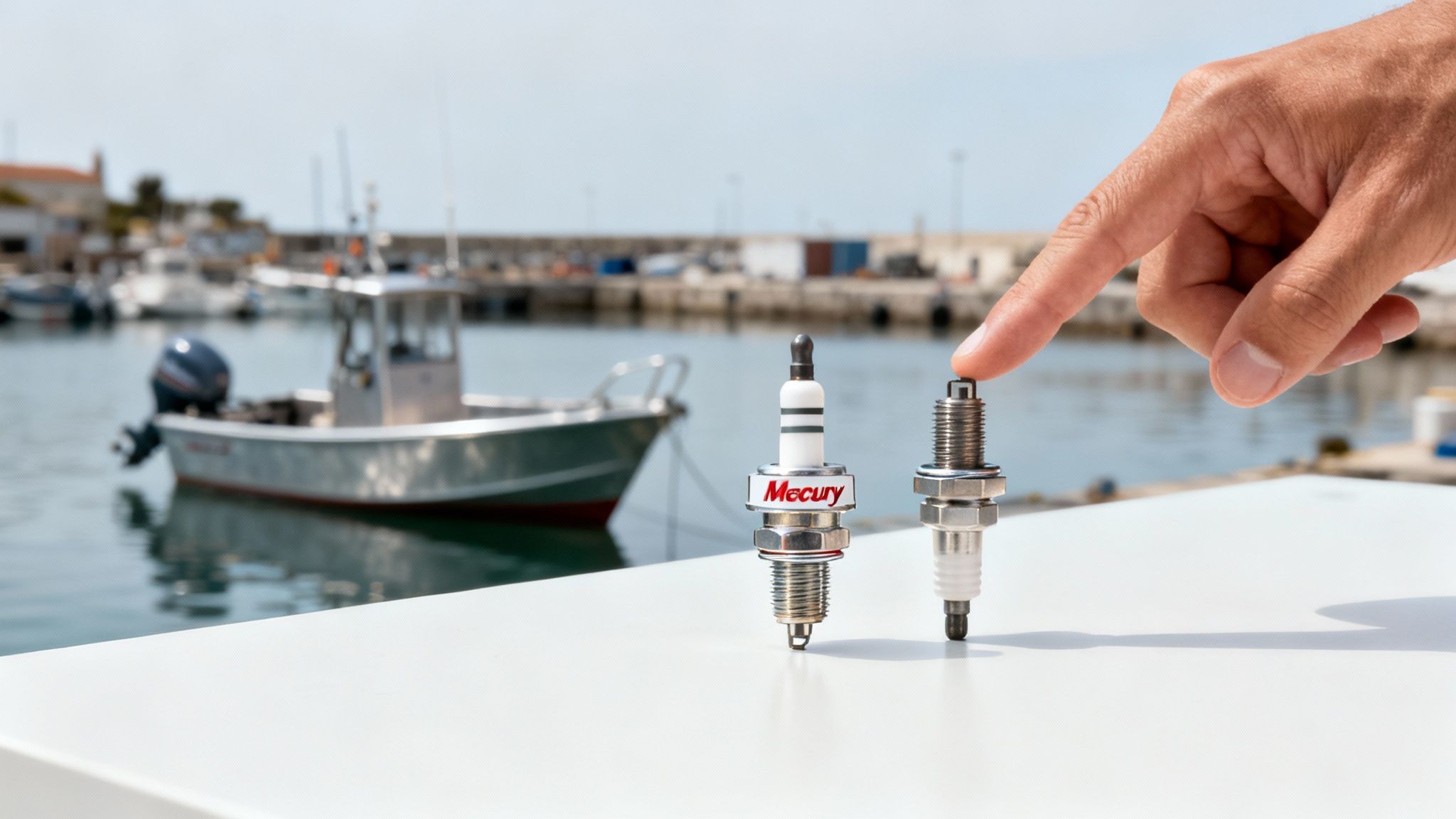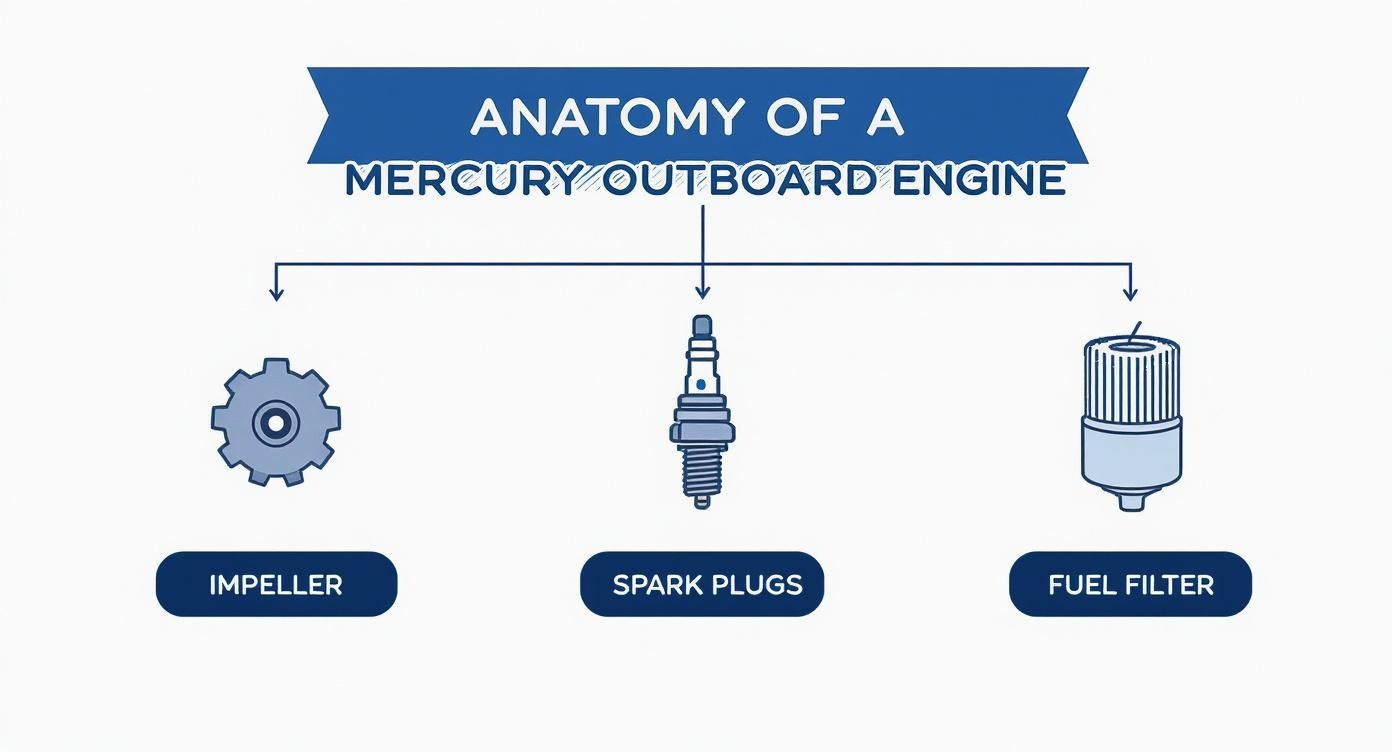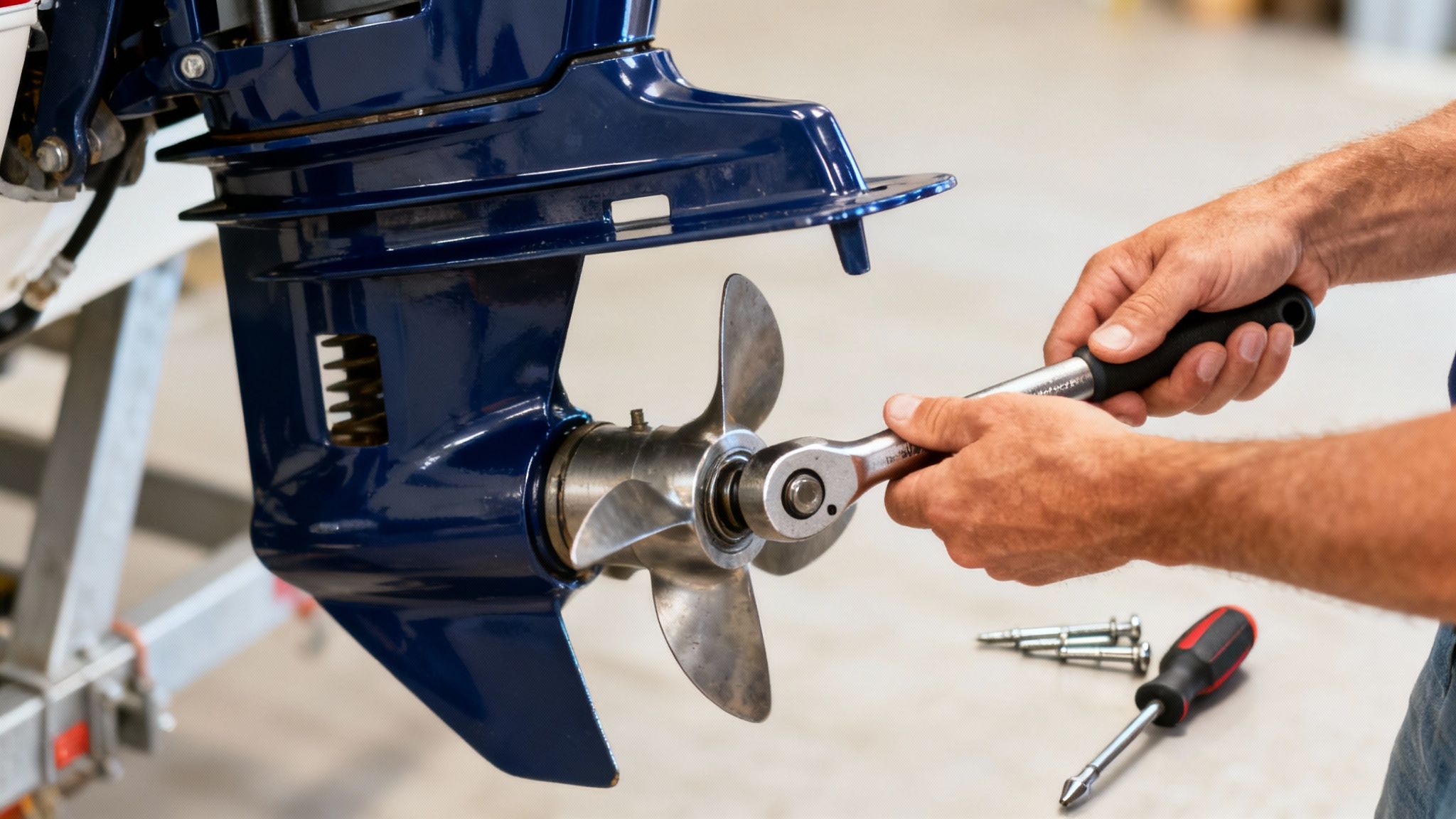
When you're searching for boat motor parts Mercury, you're really looking for one thing: confidence. You want the confidence that your engine will fire up every time, run smoothly, and get you back to the boat ramp safely. That’s where genuine Mercury parts come in. They aren't just components; they're the lifeblood of your motor, engineered for a perfect fit and flawless function, ensuring your days on Australian waters are all fun and no fuss.

Think of your Mercury outboard like a finely tuned Swiss watch. Every gear and spring is designed to work in perfect harmony. If one piece is even a fraction of a millimetre off, the whole system can fail. The same goes for your engine. Genuine boat motor parts Mercury are designed to work in perfect sync with every other component.
This isn't just about a part fitting into place. It’s about total system integrity. From a simple fuel filter to a complex water pump impeller, each genuine part is manufactured to the exact specifications and tolerances set by the engineers who designed your motor in the first place. That precision is what delivers optimal performance, better fuel efficiency, and the long-term durability you expect from a Mercury.
Every boat owner eventually faces this choice: go with OEM (Original Equipment Manufacturer) parts or save a few bucks with an aftermarket alternative. While the lower price tag on aftermarket options can be tempting, it often comes with hidden risks.
Using genuine parts is an investment in peace of mind. You know it’s going to fit right, work right, and won't compromise the health of your engine. This is absolutely critical for systems like fuel and cooling, where a cheap part failing could leave you stranded miles from shore.
Choosing genuine Mercury parts isn’t just about maintenance; it’s a commitment to reliability. It guarantees every component meets strict quality standards, protecting your engine's longevity and your safety on the water.
Here in Australia, Mercury is a powerhouse on the water for a reason. Its reputation has been built over decades of reliable performance on our unique and often harsh waterways. It's no surprise that Mercury Marine holds a massive share of the boat motor parts and outboard sales in the country's propulsion sector.
Sticking with genuine boat motor parts Mercury is also one of the smartest things you can do to protect your boat's resale value. A well-maintained engine with a service log showing it's been cared for with official components is a huge selling point. It tells potential buyers you took no shortcuts and cared for your vessel properly, making it a far more attractive and trustworthy purchase.
Whether you're a serious angler chasing that trophy fish or just enjoying a weekend out with the family, using genuine parts is the best way to protect both your passion and your investment. You can find a huge range of official Mercury outboard parts on our site to get exactly what you need.
Think of your Mercury outboard not as a piece of machinery, but as a living, breathing partner on the water. Just like a human body, it has vital organs working in harmony to create power and motion. Getting to know what’s under the cowling isn’t just for mechanics; it’s essential for any boat owner who wants to keep their engine running smoothly and stay safe.
When you lift that cover, it can look a bit intimidating. But the truth is, a few key boat motor parts Mercury owners should familiarise themselves with are responsible for most of the routine maintenance. These are the workhorses of your engine, and they're the ones most likely to wear out. We'll focus on three of the most critical: the impeller, spark plugs, and fuel filter.
Your Mercury motor generates a massive amount of heat, and just like a car, it needs a cooling system to stop it from cooking itself. That's where the impeller comes in. It’s a small, flexible rubber rotor tucked away inside the water pump, located in the lower unit of your outboard.
The impeller's job is simple but absolutely crucial. It spins like a top to pull in cool water from the lake or ocean and pushes it through the engine's powerhead. This constant flow is the only thing standing between your engine and a catastrophic meltdown.
Replacing an impeller is a proactive job that can save you thousands in repair bills. It’s the difference between a minor service at the dock and a major engine rebuild.
If the impeller is the cooling system, then the spark plugs are the very heart of your engine’s power. They create that tiny, powerful bolt of lightning that ignites the fuel-air mix inside the cylinders. This controlled explosion is what drives the pistons, turns the crankshaft, and ultimately, spins your propeller.
For your Mercury engine to run at its peak, that spark needs to be strong and perfectly timed. Worn-out or dirty spark plugs can cause a whole host of performance problems that can easily ruin a day on the water.
A healthy spark plug is a window into your engine's soul. Its condition can tell you a lot about how well your motor is burning fuel, the quality of that fuel, and its overall internal health. Pulling them out for a quick look is like giving your engine a check-up.
Common symptoms of failing spark plugs include struggling to start, a rough idle, sluggish acceleration, and a noticeable drop in fuel economy. These small, inexpensive parts have a huge impact on your motor's performance. Keeping a spare set on board is always a smart move.
Finally, let’s talk about the fuel filter. Think of it as the bouncer standing guard at the door to your engine's sensitive fuel system. Its one job is to trap water, dirt, sediment, and any other gunk before it can get to the fuel injectors or carburettor. Modern engines, like a 20 hp outboard engine, depend on squeaky-clean fuel to run properly.
Here in Australia, fuel quality can be a mixed bag, and condensation can easily introduce water into your tank. A clogged fuel filter will starve your engine, causing it to sputter, lose power, or stall completely—usually when you need it most.
Genuine Mercury filters are engineered with specific materials designed for the tough marine environment, doing a brilliant job of separating water from fuel while letting enough juice through. It’s a small detail that makes a massive difference to long-term engine health, preventing expensive damage to injectors and fuel pumps. Changing your fuel filter is one of the easiest and most effective ways to make sure your Mercury gets the clean "lifeblood" it needs to perform.
When it's time to maintain or repair your outboard, you’ll eventually face the classic choice: stick with the premium, original brand or go for a more budget-friendly alternative? This decision is a big one, because the quality of the boat motor parts Mercury engines rely on will directly impact how well your motor performs and how long it lasts. Here in Australia, a common showdown is between genuine Mercury parts and those from Hidea, a competitor known for its value-for-money approach.
This isn’t just about the price tag you see on the shelf. It’s a real trade-off between decades of engineering, advanced materials, and your long-term peace of mind on the water. Let’s break down the key differences to help you make a smart call that fits your needs, your budget, and how you feel about risk.
Genuine Mercury parts are born from millions of dollars in research and development. The specific metals, alloys, and plastics they use are hand-picked and torture-tested to survive the brutal marine environment—we’re talking constant vibration, corrosive saltwater, and wild temperature swings. Every single part is also made to incredibly tight tolerances, which guarantees it will fit perfectly and work seamlessly with the rest of your engine.
Hidea parts, on the other hand, are designed to give you a cost-effective fix. They get the job done, but they often use more standardised materials that might not have the same hardcore corrosion resistance or durability as their Mercury counterparts. The manufacturing precision can also be a little looser, which could lead to tiny fitment issues that create extra vibration or cause premature wear down the track.
The real difference is often in the metallurgy. A genuine Mercury water pump housing, for example, is made from a specific corrosion-resistant alloy built for thousands of hours in saltwater. A budget alternative might use a more generic metal that works fine at first but could start showing pitting or breaking down much sooner.
Knowing a bit about the guts of your Mercury engine makes it clear why these differences are so important. This infographic shines a light on the key components where quality is everything.

As you can see, parts like the impeller, spark plugs, and fuel filter are the lifeblood of your engine. The materials they’re made from have a direct say in how long they last and how well they perform.
Out on the water is where those engineering differences really show up. Take a genuine Mercury propeller. It’s not just a set of blades; it’s designed with complex geometry to squeeze out every bit of thrust and fuel efficiency for a specific engine model. A Hidea prop will get you moving, but it's unlikely to be as perfectly tuned, which might mean slightly lower top speeds or a bit more fuel burn.
The same idea applies to the internal bits and pieces.
Long-term durability is the biggest question mark. Mercury parts are built to go the distance, lasting the full service life your owner’s manual recommends. Aftermarket parts can be more of a gamble; some might last just as long, while others could fail early, potentially causing a domino effect that damages more expensive components.
Choosing between these two brands really boils down to balancing the upfront cost against long-term value and your own peace of mind. To make it crystal clear, we've put together a table comparing them across the most important attributes.
Here’s a straightforward look at what you get for your money when choosing between genuine Mercury parts and their Hidea counterparts. This should help you weigh the pros and cons based on your specific needs.
| Attribute | Mercury Genuine Parts | Hidea Parts |
|---|---|---|
| Initial Price | Higher initial investment reflects R&D, premium materials, and brand assurance. | Significantly lower upfront cost, making them attractive for budget-conscious repairs. |
| Fit and Finish | Guaranteed perfect fit, designed to exact factory specifications. | Generally good fit, but minor variations in tolerance can sometimes occur. |
| Material Quality | Uses proprietary, corrosion-resistant alloys and polymers for maximum durability. | Utilises more standard, cost-effective materials that are functional but may wear faster. |
| Performance | Optimised for maximum efficiency, power output, and fuel economy for specific models. | Provides reliable, standard performance but may lack the fine-tuning of OEM parts. |
| Warranty | Backed by Mercury's official warranty, protecting your engine's overall coverage. | Typically comes with its own limited warranty, but may void your engine's factory warranty. |
If you're keen to understand why budget-friendly options are so popular, you can learn more about Hidea outboard motors' value-driven approach in our detailed guide.
Ultimately, the best choice depends on your situation. If you're replacing a critical component on an engine that's still under warranty, going with genuine Mercury is the only sensible path. But for an older motor that needs a simple, non-critical part, a Hidea alternative could be a perfectly practical and wallet-friendly solution.
Trying to source the right boat motor parts Mercury engines need in Australia can sometimes feel like you’re navigating choppy waters. Between local dealerships and a seemingly endless list of online stores, knowing where to turn for reliable components is key. Making the right choice gets you authentic parts quickly and helps you dodge those costly mistakes that keep your boat high and dry.
Your search will generally lead you down two main paths: authorised Mercury dealers or trusted online suppliers. Each has its own strengths, and they’re suited to different needs and timelines. Understanding the pros and cons of both will help you make a smart, informed decision every single time you need a part.
The traditional route, of course, is heading down to an authorised Mercury Marine dealer. The biggest advantage here is the expertise. You can walk in, have a chat with a trained technician, and get hands-on advice, which is absolutely invaluable if you're not 100% sure what you need.
On the other hand, online suppliers offer incredible convenience and often more competitive prices. These websites give you access to a massive inventory of boat motor parts Mercury owners might need, covering everything from common service items to those harder-to-find components. The trade-off? You’re taking on the responsibility of making sure you order the exact part for your engine model.
For many Aussies, the decision boils down to balancing cost against confidence. If you're tackling a simple job like swapping out a fuel filter, an online store is a fantastic option. But for something more critical, like a water pump kit, the peace of mind you get from a dealer might be well worth the extra cost.
Here’s the single most important tip to avoid buying the wrong part: always use your engine’s serial number. Think of this unique number as your outboard's fingerprint. You’ll usually find it on a sticker on the transom bracket, and it tells a dealer or an online parts finder everything about your motor—its year, model, and specific build.
Using your serial number completely removes the guesswork. It links you directly to the precise parts diagram for your specific engine, guaranteeing that the part you order is the one designed to fit and function perfectly.
Trying to buy parts based on just the horsepower and year is a recipe for disaster, as Mercury often makes subtle design changes mid-production. The serial number is your foolproof way to get it right the first time.
The Australian outboard motor market is thriving, reflecting our country's deep-seated passion for boating. This market is part of a much larger trend across the Asia-Pacific, where the global sector was valued at $9.32 billion in 2025 and is projected to hit $11.93 billion by 2030.
But this growth also means boaters need to be aware of what’s happening in the market. Global supply chain issues can sometimes affect the availability and price of the specific boat motor parts Mercury engines rely on. This might mean longer wait times for certain components, so it pays to plan your maintenance projects ahead of time. Staying on top of current Mercury outboard motor pricing can also help you budget for both parts and potential labour costs.
By planning ahead and always using your serial number, you can navigate the Australian market with confidence and keep your engine in peak condition for years to come.

There’s a special kind of satisfaction that comes from getting your hands dirty and knowing your boat inside and out. Learning to handle your own essential maintenance not only saves you a fair bit on labour costs, but it also builds your confidence for when you're out on the water.
This guide is all about empowering you to tackle some of the most common replacement jobs on your Mercury motor. We'll walk you through three key jobs that are well within reach for most boaties with a bit of patience and the right gear: swapping the impeller, the spark plugs, and the all-important fuel filter.
Before you even think about reaching for a spanner, let's talk safety. An outboard motor combines fuel, electricity, and moving parts, so a few simple precautions are non-negotiable.
First up, always disconnect the battery. This single step prevents any chance of the engine accidentally starting or causing an electrical short. Make sure you’re working in a well-ventilated space, especially when fuel is involved, to avoid breathing in fumes. It’s also just good workshop practice to have a fire extinguisher within arm’s reach.
A final tip from experience: lay down an old towel or a mat. It’ll save you a headache when—not if—you drop a small screw or washer.
You don't need a professional workshop to get these jobs done, but the right tools will make life a whole lot easier. A decent marine toolkit is a great start.
Think of your fuel filter as the guardian of your engine's internal components. It’s a quick, simple job that makes a massive difference to performance and reliability. A clogged filter will starve your engine of fuel, causing it to lose power or stall completely.
A clean fuel system is the heart of a healthy outboard. For a deeper dive, you can learn more about the importance of a clean outboard engine fuel line and how it keeps your motor running smoothly.
Changing spark plugs is another straightforward job. Just pull off the plug lead, use your spark plug socket to gently unscrew the old plug, and have a look at its condition. When installing the new one, thread it in by hand first to avoid cross-threading, then tighten it to the torque specified in your manual.
Replacing the water pump impeller is a bit more involved because it means dropping the lower unit (the gearcase). While it sounds complex, it's a critical bit of preventative maintenance. The basic process involves unbolting the gearcase, opening the water pump housing, swapping out the old impeller and gaskets, and then carefully putting it all back together. For this task, follow your manual’s instructions to the letter to ensure everything is aligned perfectly.
The marine industry is in the middle of a massive shake-up, and the world of boat motor parts Mercury owners know is changing right along with it. It’s a lot like what we’ve seen with cars moving towards electric power—the boating world is steering towards a quieter, cleaner future. This isn't just about new gadgets; it's a shift driven by better technology and a growing desire among boaters to enjoy Australia's incredible waterways more sustainably.
Mercury Marine isn't just riding this wave; they're out in front, shaping it. The company is pouring huge resources into developing technologies that are set to redefine what boating feels like. This means looking beyond the traditional petrol engine and exploring smarter, more efficient propulsion systems that are kinder to the environment. For boat owners, getting your head around these trends is crucial for making smart decisions, whether you're thinking about an upgrade or a whole new boat.
The biggest change on the horizon is, without a doubt, the move to electric and hybrid power. While the roar of a petrol outboard is a classic sound on the water, the silent glide of an electric motor is winning over a lot of boaties. Mercury has jumped right into this space with its Avator series of electric outboards, perfect for smaller boats like tenders and tinnies where a clean, quiet, and simple experience is key.
These new systems bring a completely different set of components into the mix. Forget spark plugs and fuel filters; the future is all about advanced battery systems, sleek electric motors, and intelligent power management controllers. This means the boat motor parts Mercury mechanics will be stocking in the years to come will look very different.
This shift isn't just a niche trend. Data from the Australian outboard motor market shows that electric motors are really starting to pick up steam, mirroring a global push toward zero-emission boating. You can dive deeper into these market forecasts and see how Australia's boating scene is changing by reading the full research on Australian outboard motor trends.
It’s not all about going fully electric, though. Mercury is also making its petrol engines cleaner and more fuel-efficient than ever before. Tighter environmental regulations and pressure from boat owners are pushing for outboards that produce fewer emissions and burn less fuel. That saves you money at the pump and reduces your environmental footprint.
The future of marine power isn't a one-size-fits-all solution. It's about offering a whole spectrum of choices, from ultra-efficient four-stroke engines to advanced hybrid systems, so boaters can pick the power that best fits their needs and values.
This focus on efficiency influences the design of everything from the fuel injectors to the engine control units (ECUs). The boat motor parts Mercury is engineering today are designed to squeeze every last drop of performance out of each litre of fuel. This commitment ensures that even traditional outboards will remain a smart, responsible choice for Aussie boaters for years to come, acting as a practical bridge to an all-electric future.
Got a question about Mercury parts? You're not alone. Here are some of the most common queries we hear from boat owners, with straightforward answers to help you get back on the water with confidence.
It's a tempting thought, but when it comes to your engine, genuine is almost always the way to go. Genuine Mercury parts are engineered and tested specifically for your motor, which means they guarantee a perfect fit, reliable performance, and the longevity you expect.
Using genuine parts also keeps your engine's warranty intact—a critical factor, especially for newer outboards. While some quality aftermarket options exist, you're rolling the dice on compatibility and long-term reliability.
The single most reliable way is to use your engine's serial number. Think of it as your motor's fingerprint—it's unique. You'll usually find it on a small sticker on the transom bracket.
Once you have that number, you can punch it into the official Mercury Marine parts website or give it to an authorised dealer. This will bring up the exact parts diagram for your specific motor, completely eliminating the guesswork.
This depends on your usage, but there are some good rules of thumb. Your water pump impeller should be inspected every season and replaced every 1-2 years. Spark plugs are typically good for about 100 hours of use or one year, whichever comes first.
However, your owner's manual is your ultimate guide. Always check it for the specific service schedule recommended for your Mercury model to keep it running in top form.
Ready to gear up for your next adventure on the water? Easy Inflatables has a wide selection of boats and accessories to get you started. Explore our range today at https://easyinflatables.com.au.
Experience the ultimate freedom on the water with our top-quality inflatable boats and accessories. Easy Inflatables is your trusted partner, providing everything you need for a safe and unforgettable adventure.
At Easy Inflatables, we believe in empowering adventurers with high-quality inflatable solutions. Our commitment to durability and performance ensures that every product enhances your outdoor experiences.